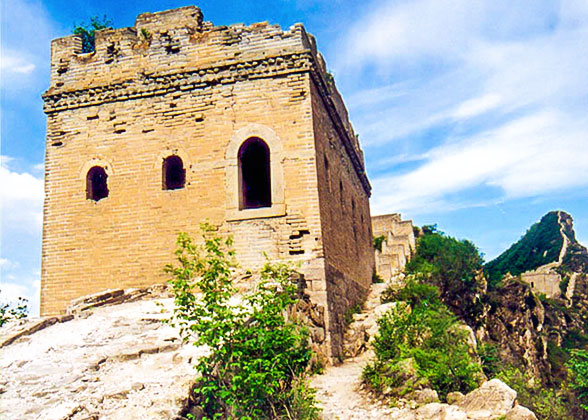Xifengkou and Panjiakou Underwater Great Wall
 |
| Xifengkou in Hebei |
The Underwater Great Wall at Xifengkou and Panjiakou is now a highlight of the Panjiakou Reservoir Scenic Area. Its main parts have been submerged underwater, which makes it a unique sight. Seen from the top of the mountains, the winding wall is like a giant dragon crawling to the lake bank and diving into the water. After swimming for a while, this 'dragon' emerges from the water again, climbing up the ridges and lying between the lofty mountains.
Why is the Great Wall Underwater?
Like other sections, Xifengkou and Panjiakou used to be strong fortresses standing between the mountains. Due to the construction of the Panjiakou Reservoir, also called Panlong Lake, a large part of them was drowned. Only a small part, which stands on relatively high land, is left above water.
Xifengkou Gateway and Panjiakou Pass
Xifengkou is one of thirty-two important Great Wall passes built by General Xu Da during the Ming Dynasty (1368 – 1644). It used to have three gateways linked by an array of strong stone walls. Once embraced by the lofty mountains on three sides and a lake on the other side, Xifengkou was very easy to hold but hard to attack. It also functioned as a major passage leading to central China from the northern frontier areas, making it historically a battlefield.
Panjiakou was built in 1562. With the Luanhe River flowing through and mountains on both sides, it also possessed a strategic location. Connected with Xifengkou by a segment of wall on mountain ridges, they together established a solid defensive line.
How to Tour the Underwater Great Wall
![]() The Great Wall is in the inner area of the reservoir, so you need to take a yacht or a boat to get there.
The Great Wall is in the inner area of the reservoir, so you need to take a yacht or a boat to get there.
| Ship | CNY 80/ person |
| Yacht | CNY 400/ yacht |
![]() Floating over the water, you can admire the ancient Great Wall with typical northern China features and the scenic water-mountain landscape of southern China characteristics at the same time.
Floating over the water, you can admire the ancient Great Wall with typical northern China features and the scenic water-mountain landscape of southern China characteristics at the same time.
![]() You can also disembark to climb the segments above water. However, you must be careful as it has not been repaired for a long time.
You can also disembark to climb the segments above water. However, you must be careful as it has not been repaired for a long time.
![]() If you have taken professional diving training previously, diving to explore the watchtowers would be a unique way to view the Great Wall, and will surely leave you with an unforgettable memory. However, this is not recommended for regular visitors.
If you have taken professional diving training previously, diving to explore the watchtowers would be a unique way to view the Great Wall, and will surely leave you with an unforgettable memory. However, this is not recommended for regular visitors.
![]() The scenic area is also a great place to have fun with families and friends. On the shore, you can go fishing or have a picnic on the bank.
The scenic area is also a great place to have fun with families and friends. On the shore, you can go fishing or have a picnic on the bank.
| Admission Fee | CNY 30 |
How to Get to the Underwater Great Wall
It is located about 40 miles (60 kilometers) northwest of Qianxi County, Tangshan City of Hebei Province. You should get to Qianxi first by coach. It takes about an hour and a half from Tangshan City. Once arriving, you can either take a taxi directly to the scenic area (Fare: about CNY 125), or take a coach to Luanyang and then rent a car to get there.
![]() Coach Schedule (for reference only)
Coach Schedule (for reference only)
| Coach | Time | Fare |
|---|---|---|
| From Tangshan East Long-distance Bus Station to Qianxi | 5:30, 6:00, 7:15, 8:00, 9:00, 11:00, 11:15, 11:45, 12:05, 12:20, 12:45, 13:30, 14:00, 14:10, 14:45, 16:00, 17:00 | CNY 25 |
| From Tangshan West Long-distance Bus Station to Qianxi | 6:30, 7:30, 7:50, 9:30, 12:10, 12:50, 13:20, 15:30 | CNY 25 |
| From Tangshan Fengrun Bus Station to Qianxi | 5:30, 7:00, 7:50, 9:00, 10:01, 10:25, 11:30, 12:13, 12:20, 12:50, 13:00, 13:05, 13:15, 13:25, 13:35, 13:50, 14:05, 14:20, 14:50, 15:10, 15:45, 16:30, 16:50, 17:05, 18:40 | CNY 20 |
| From Qianxi Bus Station to Luanyang | 6:10, 7:30, 8:00, 9:00, 9:10, 10:10, 10:50, 11:10, 11:30, 12:00, 13:20, 13:30, 14:20, 15:10, 16:30, 20:49, 20:50 | CNY 15 |
Where to Stay and Dine
There are farmhouses dotted around the reservoir offering dining and accommodations. If you want to taste the local dishes or even spend the night there to experience rural life, you are welcomed.